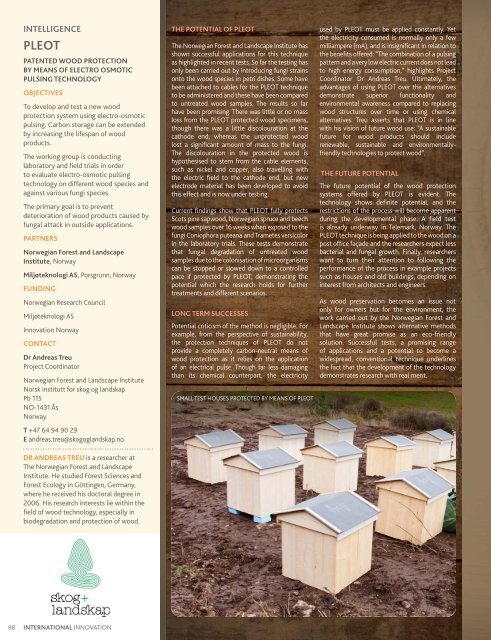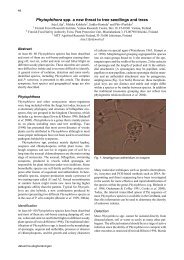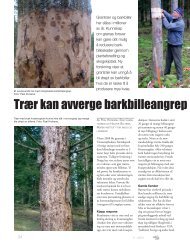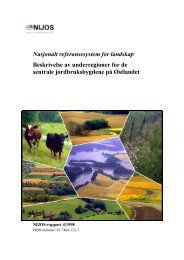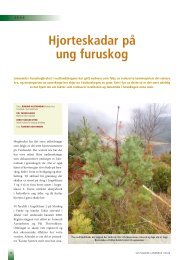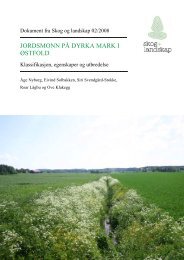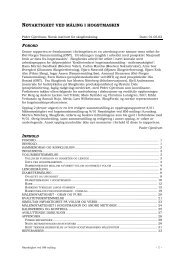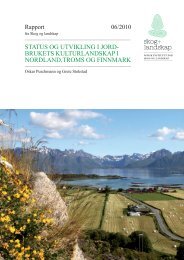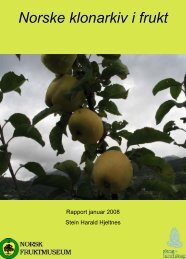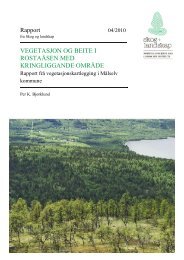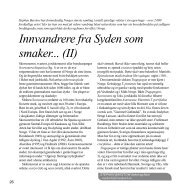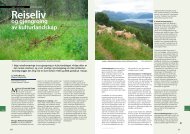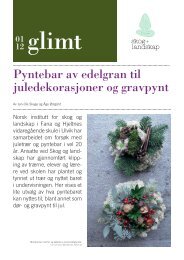Timber technology - Skog og landskap
Timber technology - Skog og landskap
Timber technology - Skog og landskap
Create successful ePaper yourself
Turn your PDF publications into a flip-book with our unique Google optimized e-Paper software.
INTELLIGENCE<br />
PLEOT<br />
PATENTED WOOD PROTECTION<br />
BY MEANS OF ELECTRO OSMOTIC<br />
PULSING TECHNOLOGY<br />
OBJECTIVES<br />
To develop and test a new wood<br />
protection system using electro-osmotic<br />
pulsing. Carbon storage can be extended<br />
by increasing the lifespan of wood<br />
products.<br />
The working group is conducting<br />
laboratory and fi eld trials in order<br />
to evaluate electro-osmotic pulsing<br />
<strong>technol<strong>og</strong>y</strong> on different wood species and<br />
against various fungi species.<br />
The primary goal is to prevent<br />
deterioration of wood products caused by<br />
fungal attack in outside applications.<br />
PARTNERS<br />
Norwegian Forest and Landscape<br />
Institute, Norway<br />
Miljøteknol<strong>og</strong>i AS, Porsgrunn, Norway<br />
FUNDING<br />
Norwegian Research Council<br />
Miljøteknol<strong>og</strong>i AS<br />
Innovation Norway<br />
CONTACT<br />
Dr Andreas Treu<br />
Project Coordinator<br />
Norwegian Forest and Landscape Institute<br />
Norsk institutt for sk<strong>og</strong> <strong>og</strong> <strong>landskap</strong><br />
Pb 115<br />
NO-1431 Ås<br />
Norway<br />
T +47 64 94 90 29<br />
E andreas.treu@sk<strong>og</strong><strong>og</strong><strong>landskap</strong>.no<br />
DR ANDREAS TREU is a researcher at<br />
The Norwegian Forest and Landscape<br />
Institute. He studied Forest Sciences and<br />
Forest Ecol<strong>og</strong>y in Göttingen, Germany,<br />
where he received his doctoral degree in<br />
2006. His research interests lie within the<br />
fi eld of wood <strong>technol<strong>og</strong>y</strong>, especially in<br />
biodegradation and protection of wood.<br />
98 INTERNATIONAL INNOVATION<br />
THE POTENTIAL OF PLEOT<br />
The Norwegian Forest and Landscape Institute has<br />
shown successful applications for this technique<br />
as highlighted in recent tests. So far the testing has<br />
only been carried out by introducing fungi strains<br />
onto the wood species in petri dishes. Some have<br />
been attached to cables for the PLEOT technique<br />
to be administered and these have been compared<br />
to untreated wood samples. The results so far<br />
have been promising. There was little or no mass<br />
loss from the PLEOT protected wood specimens,<br />
though there was a little discolouration at the<br />
cathode end, whereas the unprotected wood<br />
lost a signifi cant amount of mass to the fungi.<br />
The discolouration in the protected wood is<br />
hypothesised to stem from the cable elements,<br />
such as nickel and copper, also travelling with<br />
the electric fi eld to the cathode end, but new<br />
electrode material has been developed to avoid<br />
this effect and is now under testing.<br />
Current fi ndings show that PLEOT fully protects<br />
Scots pine sapwood, Norwegian spruce and beech<br />
wood samples over 16 weeks when exposed to the<br />
fungi Coniophora puteana and Trametes versicolor<br />
in the laboratory trials. These tests demonstrate<br />
that fungal degradation of untreated wood<br />
samples due to the colonisation of microorganisms<br />
can be stopped or slowed down to a controlled<br />
pace if protected by PLEOT, demonstrating the<br />
potential which the research holds for further<br />
treatments and different scenarios.<br />
LONG TERM SUCCESSES<br />
Potential criticism of the method is negligible. For<br />
example, from the perspective of sustainability,<br />
the protection techniques of PLEOT do not<br />
provide a completely carbon-neutral means of<br />
wood protection as it relies on the application<br />
of an electrical pulse. Though far less damaging<br />
than its chemical counterpart, the electricity<br />
SMALL TEST HOUSES PROTECTED BY MEANS OF PLEOT<br />
used by PLEOT must be applied constantly. Yet<br />
the electricity consumed is normally only a few<br />
milliampere (mA), and is insignifi cant in relation to<br />
the benefi ts offered: “The combination of a pulsing<br />
pattern and a very low electric current does not lead<br />
to high energy consumption,” highlights Project<br />
Coordinator Dr Andreas Treu. Ultimately, the<br />
advantages of using PLEOT over the alternatives<br />
demonstrate superior functionality and<br />
environmental awareness compared to replacing<br />
wood structures over time or using chemical<br />
alternatives. Treu asserts that PLEOT is in line<br />
with his vision of future wood use: “A sustainable<br />
future for wood products should include<br />
renewable, sustainable and environmentallyfriendly<br />
technol<strong>og</strong>ies to protect wood”.<br />
THE FUTURE POTENTIAL<br />
The future potential of the wood protection<br />
systems offered by PLEOT is evident. The<br />
<strong>technol<strong>og</strong>y</strong> shows defi nite potential, and the<br />
restrictions of the process will become apparent<br />
during the developmental phase. A fi eld test<br />
is already underway in Telemark, Norway. The<br />
PLEOT technique is being applied to the wood on a<br />
post offi ce façade and the researchers expect less<br />
bacterial and fungal growth. Finally, researchers<br />
want to turn their attention to following the<br />
performance of the process in example projects<br />
such as houses and old buildings, depending on<br />
interest from architects and engineers.<br />
As wood preservation becomes an issue not<br />
only for owners but for the environment, the<br />
work carried out by the Norwegian Forest and<br />
Landscape Institute shows alternative methods<br />
that have great promise as an eco-friendly<br />
solution. Successful tests, a promising range<br />
of applications and a potential to become a<br />
widespread, conventional technique underlines<br />
the fact that the development of the <strong>technol<strong>og</strong>y</strong><br />
demonstrates research with real merit.


